Landkreis Emsland is a district in Lower Saxony, Germany named after the river Ems. It is bounded by the districts of Leer, Cloppenburg and Osnabrück, the state of North Rhine-Westphalia, the district of Bentheim in Lower Saxony, and the Netherlands.

Meppen is a town in and the seat of the Emsland district of Lower Saxony, Germany, at the confluence of the Ems, Hase, and Nordradde rivers and the Dortmund–Ems Canal (DEK). The name stems from the word Mappe, meaning "delta".

"The March" refers to a series of forced marches during the final stages of the Second World War in Europe. From a total of 257,000 western Allied prisoners of war held in German military prison camps, over 80,000 POWs were forced to march westward across Poland, Czechoslovakia, and Germany in extreme winter conditions, over about four months between January and April 1945. This series of events has been called various names: "The Great March West", "The Long March", "The Long Walk", "The Long Trek", "The Black March", "The Bread March", and "Death March Across Germany", but most survivors just called it "The March".

Stalag Luft IV was a German World War II prisoner-of-war camp in Gross Tychow, Pomerania.
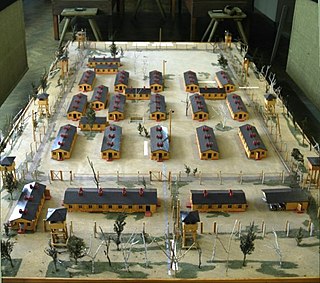
In Germany, stalag was a term used for prisoner-of-war camps. Stalag is a contraction of "Stammlager", itself short for Kriegsgefangenen-Mannschaftsstammlager, a literal translation of which is "War-prisoner" "enlisted" "main camp". Therefore, technically "stalag" simply means "main camp".
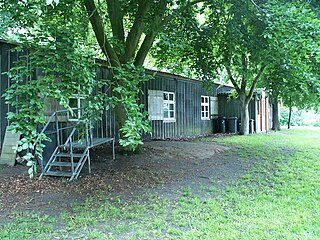
Stalag VI-B was a German World War II prisoner-of-war camp (Stammlager), located about 3 km (1.9 mi) east of the village of Versen in the Emsland district of Lower Saxony, in north-western Germany, close to the border with the Netherlands.

Stalag III-A was a German World War II prisoner-of-war camp at Luckenwalde, Brandenburg, 52 kilometres (32 mi) south of Berlin.
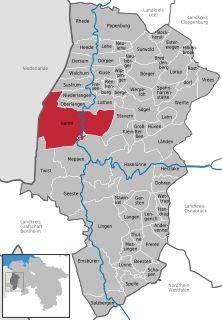
Haren is a town in Lower Saxony, Germany in the district of Emsland.

Stalag VIII-A was a German World War II prisoner-of-war camp, located just to the south of the town of Görlitz in Lower Silesia, east of the River Neisse. The location of the camp lies in today's Polish town of Zgorzelec, which lies over the river from Görlitz.

Stalag IV-B was one of the largest prisoner-of-war camps in Germany during World War II. Stalag is an abbreviation of the German Stammlager. It was located 8 km (5.0 mi) north-east of the town of Mühlberg in the Prussian Province of Saxony, just east of the Elbe river and about 30 mi (48 km) north of Dresden. From 1944 to 1945 it belonged to the Province of Halle-Merseburg. Now, the area is in Brandenburg. A sub-camp, sometimes identified as Stalag IV-B/Z,Stalag 304 or Stalag IV-H was located at Zeithain, 10 km (6.2 mi) to the south in Saxony.

Stalag VI-C was a World War II German POW camp located 6 km west of the village Oberlangen in Emsland in north-western Germany. It was originally built with five others in the same marshland area as a prison camp (Straflager) for Germans. From 1939 till 1945 the Oberlangen camp was a Prisoner of War camp.
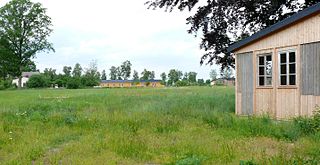
Stalag X-B was a World War II German Prisoner-of-war camp located near Sandbostel in Lower Saxony in north-western Germany. Between 1939 and 1945 several hundred thousand POWs of 55 nations passed through the camp. Due to the bad conditions in which they were housed, thousands died there of hunger, disease, or were killed by the guards. Estimates of the number of dead range from 8,000 to 50,000.

Sandbostel is a municipality in Lower Saxony (Niedersachsen) in northwestern Germany, 43 km north-east of Bremen, 60 km west of Hamburg. It is part of the Samtgemeinde Selsingen. In 2013, it had 830 inhabitants.
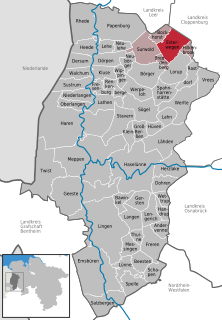
Esterwegen is a municipality in the Emsland district, in Lower Saxony, Germany.

Lähden is a municipality in the Emsland district, in Lower Saxony, Germany.

Stalag VI-K Senne was a former German World War II prisoner-of-war camp. Though named after the nearby village of Senne, it was actually closer to the town of Schloß Holte-Stukenbrock, in North Rhine-Westphalia, Germany.

During World War II, Nazi Germany engaged in a policy of deliberate maltreatment of Soviet prisoners of war (POWs), in contrast to their treatment of British and American POWs. This policy, which amounted to deliberately starving and working to death Soviet POWs, was grounded in Nazi racial theory, which depicted Slavs as sub-humans (Untermenschen). The policy resulted in some 3.3 to 3.5 million deaths.

Macikai POW and GULAG Camps - the Macikai (Matzicken) complex of a Nazi German prisoner-of-war camp (1939-1944), Soviet prisoner-of-war camp No. 184 (1945-1948) and Soviet GULAG forced-labour camps (1945-1955), that existed in Village Macikai, 2 kilometres away from Heydekrug, Memelland.
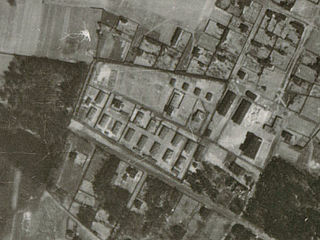
Stalag Luft II was a Luftwaffe-run prisoner-of-war (POW) camp during World War II, in Łódź, in the occupied territory of Poland.

Nazi Germany operated around 1,000 prisoner-of-war camps during World War II (1939-1945).





















